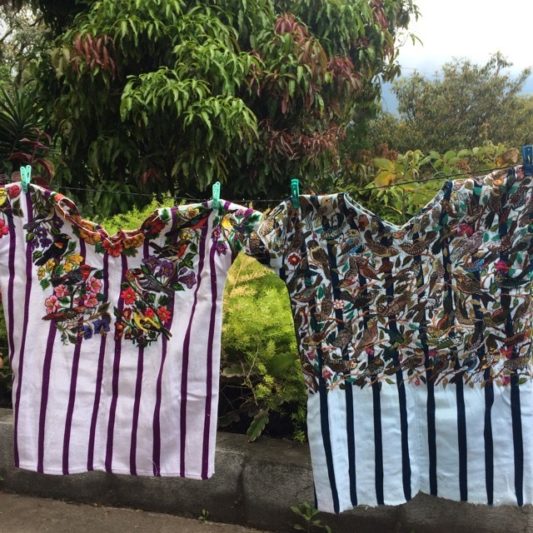
Whether you’ve been on Lake Atitlan for years or just arrived yesterday, you’ve surely noticed the most striking component of the local women’s traditional dress: the huipil. This woven garment is worn along with a corte (a long skirt made from a length of fabric) and, in some towns, a colorful headband.
The huipils in Santiago are made right in town, usually by women working from their homes. Only the thread is purchased from outside. Once the women have the thread in their hands, they rely on their skills and knowledge to do the rest. Creating one of these gorgeous garments is a quasi-magical process that involves a few surprising steps along the way. After learning just how much time, effort, and cultural wisdom goes into each huipil, you’ll be tempted to buy one from the local vendors in Santiago. They look just as fabulous on the wall as they do on a human body.
Step One: Preparing the Warp Thread
Most huipils in Santiago and around Guatemala feature striped patterns within the fabric itself. To achieve the desired pattern in the final product, the weaver must arrange the threads by color before the actual weaving begins. This is done with a wooden spinner and another wooden apparatus called a warping board. Once this thread has been arranged with the desired pattern, it’s set for several minutes within a hunk of cornmeal dough.This step gives the thread the toughness it needs for the weaving process. If you needed more evidence for the centrality of “maize” in the culture of the Guatemalan highlands, this should leave you satisfied. It seems there’s very little around Lake Atitlán, edible or otherwise, that doesn’t have at least some relationship with the ever-present Mesoamerican grain.
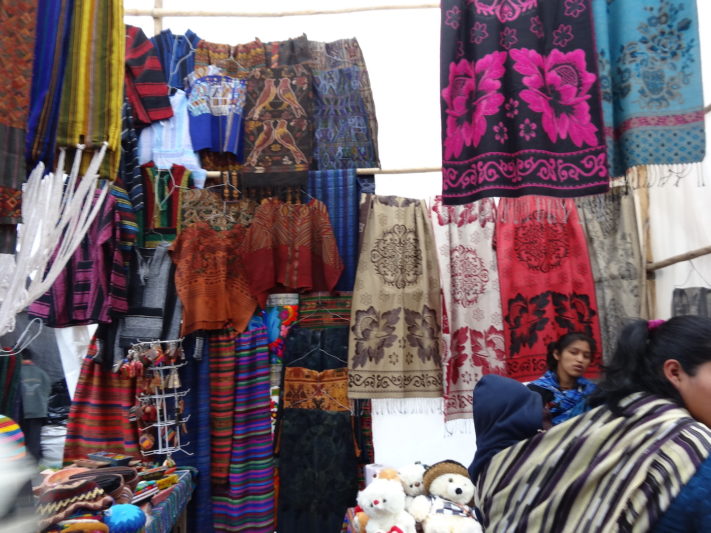
Step Two: Weaving on the Loom
Huipils in Guatemala are hand-woven with a backstrap loom, giving them an artisanal authenticity that modern clothing typically lacks. The weaver arranges the loom with the lengthwise “warp” before weaving in the “weft” thread to create colored patterns. The weaving itself is a physically grueling process, requiring hundreds of hearty thrusts with the loom. The fabric for a single huipil can take several weeks to finish.
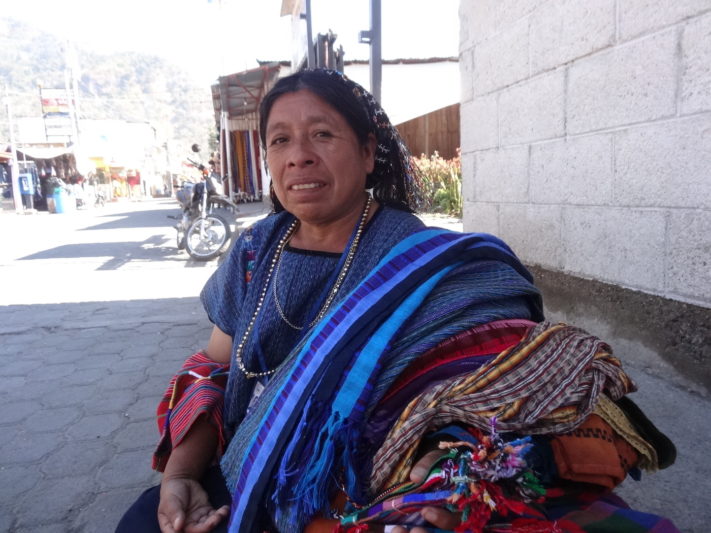
Step Three: Sewing and Cutting the Fabric Into a Huipil Shape
The freshly woven fabric comes off the loom as two rectangular pieces of fabric. To turn this fabric into a huipil, a tailor must make a pair of seams to sew the two rectangles together. A rounded cut is also made along the top of the fabric to give the huipil its collar.
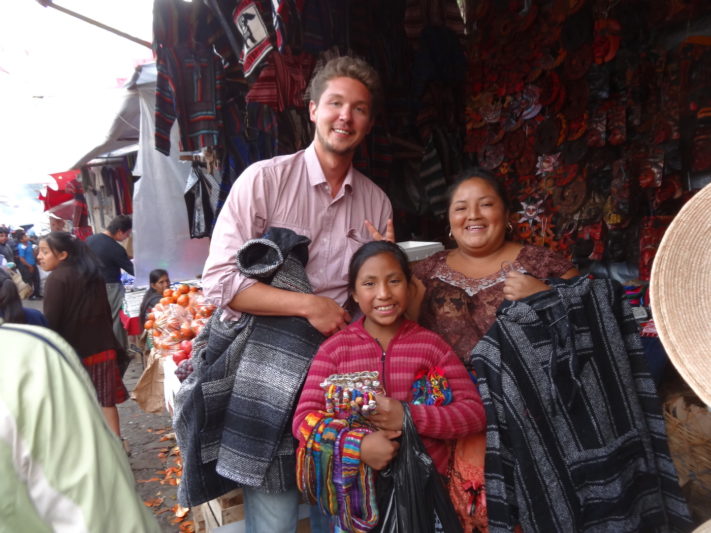
Step Four: Sketching the Design
Once the fabric has been sewn into the shape of a huipil, it’s time for an artist to draw the birds and flowers that have set Santiago’s “traje típico” apart for decades. Generations ago, most women in town wore simple white huipils with red stripes. Little by little, locals adopted the custom of decorating their garments with embroidered birds, likely in homage to the town’s name in the local Tzutujil dialect, Tz’kin Jaay (“House of Birds”). Drawing on a healthy mix of traditional and personal inspiration, the artist sketches all sorts of birds and flowers on the fabric of the huipil.
Step Five: Embroidering
Armed with a variety of colored thread and a sewing needle, an industrious woman sets about embroidering the birds and flowers that the artist has sketched. This is a time-consuming process with a single huipil often requiring weeks or even months of work. That’s why many local women sneak in a little embroidering whenever they have the chance.
If you pay close attention when walking around Santiago, you’ll see many a bent head as a shopkeeper, market woman, or chit-chatter guides their needle through a half-finished huipil. In most cases, the woman doing the embroidery chooses all her own colors. This is another part of the process in which tradition and creativity seamlessly mix. Some birds are based on actual local species, while others are simply designed to maximize the beauty of the garment.
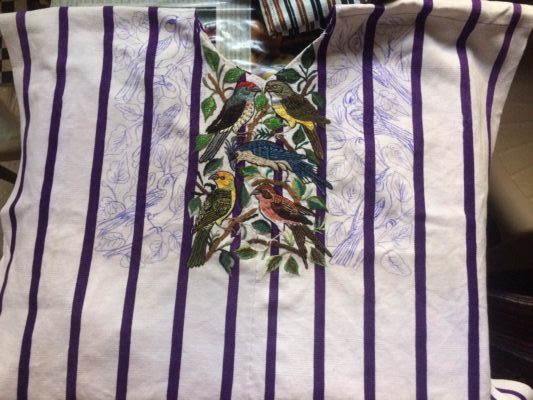
Huipils Make Great Gifts and Souvenirs
If you’re looking to commemorate a visit, buy gifts for friends, or decorate a home around the lake, consider picking up a Santiago huipil or another type of local embroidery. You’ll end up with a truly magnificent piece of local culture, an artisan masterpiece with traditional knowledge and artistic inspiration woven into every stitch.
Where to Buy Huipils Around Lake Atitlán
Huipils for sale are ubiquitous in all the towns around the lake, especially near the local markets. In Santiago, you’ll find market stalls with beautiful displays all along the main street leading up to town from the public docks. The tourist drags in Panajachel and San Pedro are also full of similar vendors. While each town will focus on huipils in the local style, you can count on discovering a decent variety almost anywhere you go. In Panajachel, for example, you’ll have no trouble finding the embroidered birds of Santiago or the gorgeous purple hues of San Antonio Palopó.
Standard Prices for Huipils
Huipils can cost anywhere from 200 to 2,000 quetzals ($25-$250) depending on the quality of the work and the extent of the embroidery. Considering the time and effort that goes into them, these remarkable garments are almost insultingly cheap. If your personal finances will allow for it, avoid haggling over the price. No matter how much or how little you pay, you’ll be getting an original piece of artwork for a bargain price. You’ll also be doing your part to reward the artisans who bring such beauty into existence.
Huipils Are Part of a Rich “Atiteca” Tradition
Santiago, like many of the towns around the lake, is a true community of artisans. Plenty of the local women would modestly reject the label “artist,” and yet they put their creativity to work every day producing some of the most gorgeous hand-made clothing in the modern world. On your next visit to Santiago, keep your eyes peeled for hands flying at remarkable speeds or the lightning flash of a needle in the sun. A careful observer will find magic happening all around them.